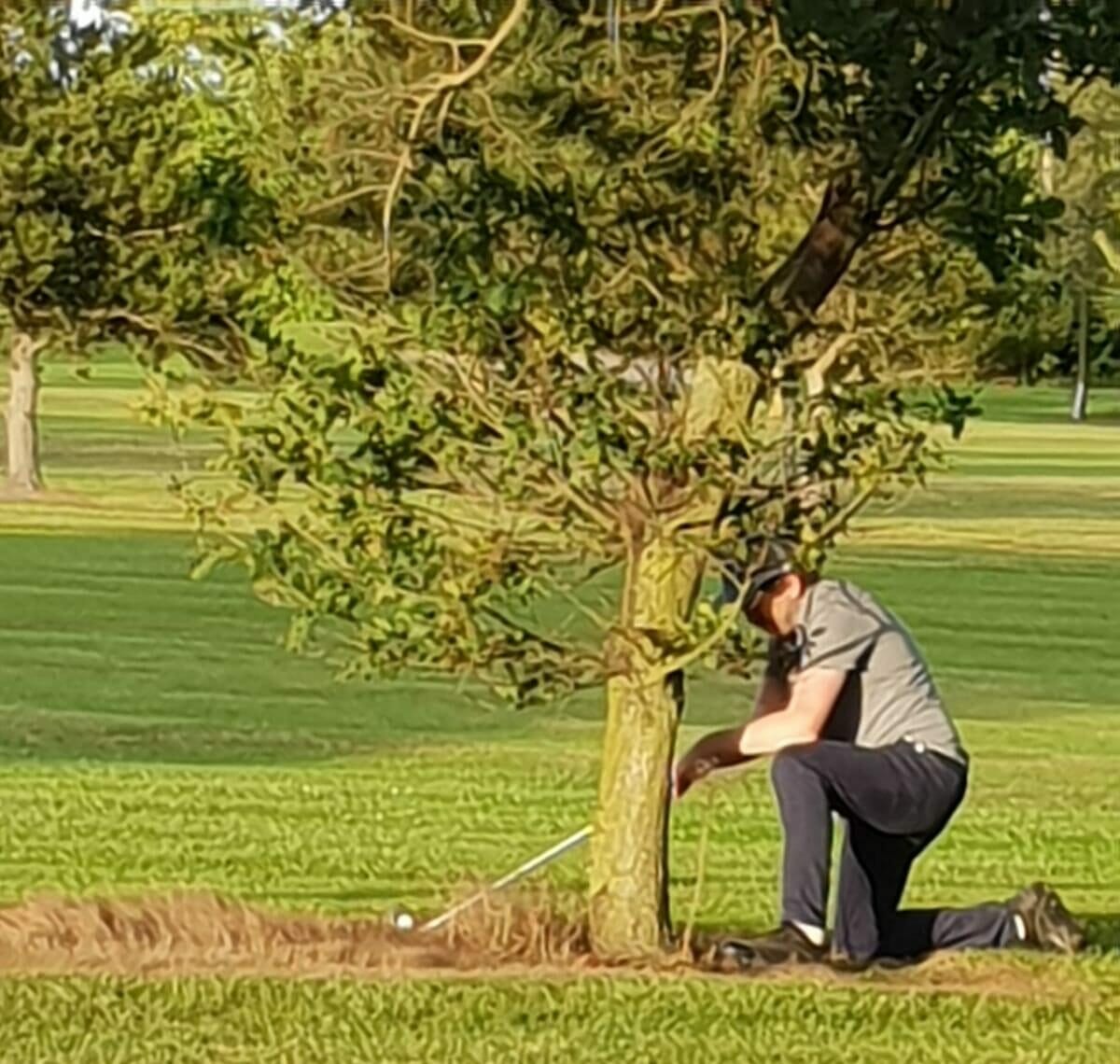It was Albert Einstein who said, “in the midst of every crisis, lies great opportunity”. Well Albert, you big genius you. You’ve only gone and done it again!
Why? Because for all the devastation caused by the pandemic known as Covid-19, there has been plenty of hope too. In golfing terms, beyond superb individual acts of charity, one major upside to the virus has seen golf clubs nationwide report an upturn in membership numbers scarcely seen since the Celtic Tiger roared over Ireland’s fairways. And it was badly needed.
If were we to go solely by the number of new membership cards printed this year, according to data compiled by the Confederation of Golf in Ireland, a whopping 19,500 new cards were printed over the months of May and June. Of that number, 91% are male and 9% are female and that can be broken down further to 80% men, 7% women, 11% boys and 2% girls.
The data doesn’t indicate whether or not a player has moved clubs, meaning after the closures of Waterrock Golf Club in Cork, Kerry’s Castleisland and Killorglin, and Offaly’s Castle Barna, the true number of new members to the game is in reality, slightly less. But the upturn remains hugely significant, a massive increase of 12,000 when comparing cards printed from November ’18 – June ‘19 to the period of November ’19 to June 2020.
90% of clubs have reported new members with an average of 57 new cards printed per club. Sure, it’s a happy consequence of a large-scale global disaster but it’s one that golf could benefit from for a while yet, so it’s not all doom and gloom.
“When we go back to mid-March when we asked clubs to close, we conducted a survey at the time and our feeling was that all aspects of the business would suffer, green fees, societies, restaurant revenue, and membership,” said GUI CEO Pat Finn of the surprising figures.
“It was a time when clubs were taking in their membership subscriptions for the year and given the indefinite nature of things, it was worrying, but as we know, that’s not how it turned out. Because we were one of the first sports back, and because you had to be a member to play, there was a premium on both golf, and golf club membership. The overall backdrop is still quite a challenging one for golf clubs but there is a silver lining in terms of golf club membership.”
Indeed, unlike other sports, golf has benefited from its privileged position of becoming one of the first active pursuits to reopen since lockdown. The sport naturally lends itself to social distancing and with team sports like football, hurling and rugby off the table for the foreseeable, many people outside golf have turned to the fairways to get their sporting fix.
Identifying their opportunity, clubs around the country, in a bid to recoup losses from an extended winter’s hibernation through to May, released affordable membership packages to entice new faces to the fairways. Beaufort Golf Club in Kerry’s €550 deal to December 2021 proved so popular they had to turn people away while other clubs found footfall with short-term workarounds for hopeful long-term gain.
“I think a small minority of clubs, because visitors weren’t allowed, had short term type memberships for very low money as a way of getting an income,” Finn explained.
“I understand why they did it but there is an argument to say that was done too cheaply. I think for the most part, what I’ve observed is that golf clubs kept their own membership structures and systems in place and we continue to see more members every day than the equivalent day last year so this isn’t the end of it. We could be looking at the end of the year at close to a 10% uplift in membership and the vast majority of those are normal memberships, they’re not low-cost deals or short-term solutions.”
“The challenge, as things get closer to normal towards next year, is to make sure golf clubs hold onto those people,” Finn adds with registered members across the island of Ireland now rising to 180,000.
“We’ll help them with that. Through the CGI we have membership retention tool kits, we’re running online workshops and online customer service surveys where we’ll facilitate a club running a survey to gauge the level of satisfaction of these new members.
“The GUI, the ILGU and the PGA set up the CGI to support clubs. We’ve always helped our clubs with membership retention. Obviously, that’s really come into focus the last couple of weeks and over the next several months it will be a real topic. We’re upping our efforts in that space and rolling out various support programmes to all the golf clubs that want to avail of it.”
Opportunity knocks for golf, hard. You don’t have to work in the industry to recognise its rising popularity. Battling tee-sheet congestion for prime slots has become the norm post-lockdown while even a bay at the local driving range comes at a premium as newcomers try and find their swings.
I decided to conduct my own survey inspired by friends who chose to turn their hand to golf as a consequence of this pandemic. Mere Pitch & Putt players, blissfully ignorant to the benefits of playing a Pro-V over a Commando, they’re the new audience that golf has been trying to attract in recent years with flashy marketing campaigns on social media. Who knew a poxy pandemic would do the trick?
I consulted 25 golfers aged between 28 and 32 to gauge their background in the sport, why they had fallen away from the game and what’s tickled their fancy to return.
A lasting image
‘Uptight’, ‘pretentious’, ‘old’, ‘unfriendly’, ‘arrogant’, and ‘elitist’.
No, not name suggestions for an eighth dwarf in a modern-day Snow White adaptation. Rather the most common responses I received when asking them what words came to mind when they thought of us golfers.
‘Time consuming’ and ‘expensive’ were the two things that same group came up with when considering the sport as a whole.
Truth be told, I didn’t need to conduct a survey to find this information out. Agree with those assumptions or not, this image of golf is widely accepted by many and certainly not unfounded. Golf is a game steeped in tradition but so often burdened by it too. A convoluted rule book, exhausting dress codes and phone calls banned in clubhouses may be some people’s idea of fun but it also contributes to the average age of a golfer being somewhere around 103.
The evidence is anecdotal but the suggestion is that the majority of new members this year have come in the form of younger men. The 25 I spoke to were born around 1990, the same year I appeared on this earth. They graduated secondary school around 2009 when the arse had well and truly fallen out of the Irish economy and upon graduating college, when junior and intermediate memberships had expired, their priorities changed and such large chunks of money could no longer justifiably go towards golf.
A race to the bottom amongst Irish golf clubs for green fees ensured there was little value for the millennial taking up a membership and as a result, golf lost a generation of players it desperately needed. Maybe it’s insensitive to be looking at this pandemic and thinking it’s time to make hay but golf has been given a second chance to capture the imaginations of young, working professionals with money in their pockets and an appetite to spend. Let’s not squander it.
Why they left
“There was a massive price difference going from under-18 membership to paying adult fees back in 2007,” says Alan McNamara who recently joined Donabate GC.
“There were no intermediate or student options offered at the time and as much and all as I would’ve loved to continue playing as a member and retain my handicap, I was ultimately priced out of it in the Dublin area.”
Being priced out of it was one thing but other respondents told me they had been turned off the game by membership committees intent on turning an enjoyable pastime into a competitive slog.
“I was a junior at Beaverstown years ago,” said one. “I joined with a group of friends and we liked to play together rather than in competitions and we eventually got kicked out for not submitting enough competition cards. I probably wouldn’t have rejoined anyway because the women members were mean!”
There were other reasons too. Almost 50% of respondents admitted that the time needed to play golf meant they could never warrant paying adult membership fees but time, it is a changin’, or at least how we value it seems to be it. Only four of the 25 players said they would’ve joined a golf club prior to the pandemic but remote working and Zoom meetings have created space in the calendar where none previously existed and golf could prove the beneficiary.
One of the major challenges the game has faced in recent years has been time. Pre-Covid, the world had never been so busy, instant gratification was in demand and golf was trying its utmost to respond with six-hole and nine-hole innovations inspired by the European Tour’s GolfSixes tournament and the time sensitive Shot Clock Masters. But this pandemic has instigated a cultural shift in how people view time and it could have long lasting effects, even for golf.
“It’s not just the working from home but the total change in behaviours,” agrees Finn.
“People have always tended to go away for weekends and jump on planes for short term trips – they’re pretty much a no go now. Things like work trips abroad have now been replaced by much more efficient means like Zoom. The amount of time that saves people is colossal.
“I’ve a sense that people’s priorities are shifting and that how we spend our time is something people are going to be a lot more careful about. Educated by the lockdown and more efficient online tools for work, there’s a real sense to me that golf will benefit from that because as a recreational activity, if you do have time to go play golf, it’s the nicest thing in the world to do.”
First impressions, second time over
Call it an accidental recruitment drive or whatever you wish but the question now is whether or not clubs can turn these new players into golfers for life that will ultimately benefit a game in desperate need of attracting a younger audience. Of the 25 I spoke to, there’s no revolutionary coming together of minds necessary to retain the majority of these players. Their hopes are small; achievable goals for golf clubs who should be grateful for their arrival.
“I’m hoping to feel some sort of affinity with Donabate that will keep me there and stop me looking around next year,” says McNamara.
“A big group of us joined wanting to improve as golfers. Obviously, we want to play enough so that the subscription remains at an affordable price point but we also want to experience what it’s like to be part of a golf club. We want to have beers in the clubhouse afterwards, get to know the members and turn the golf into a social experience and not a serious one.”
“Some of the lads didn’t even have a set of clubs when they joined,” he laughed. “One of them rocked up in his Dad’s shoes that barely fit him! The membership was just one cost. We’ve all been kitting out our wardrobes with collared shirts and buying golf balls to beat the band because we’ve been losing so many! But we’d like to think our money will be welcomed and hopefully our golf will improve too.”
For Finn, the opportunity to retain these members is a welcomed one ahead of the game’s governing bodies on the island merging under one umbrella, Golf Ireland next year.
“With the time people now have, there’s potential for a real uplift, both in terms of membership and green fee revenue,” he says.
“Courses relying on overseas tourism will be heavily hit, there’s no escaping that. But the more community type facility is now in a much stronger position. Come the end of the year, they’ll still be doing very well to balance the books, however the real opportunity – if next year is more normal and normal golfing activity is permitted throughout the course of the year – there’s a real opportunity to retain those members and that can only be good for the game.”

























Leave a comment